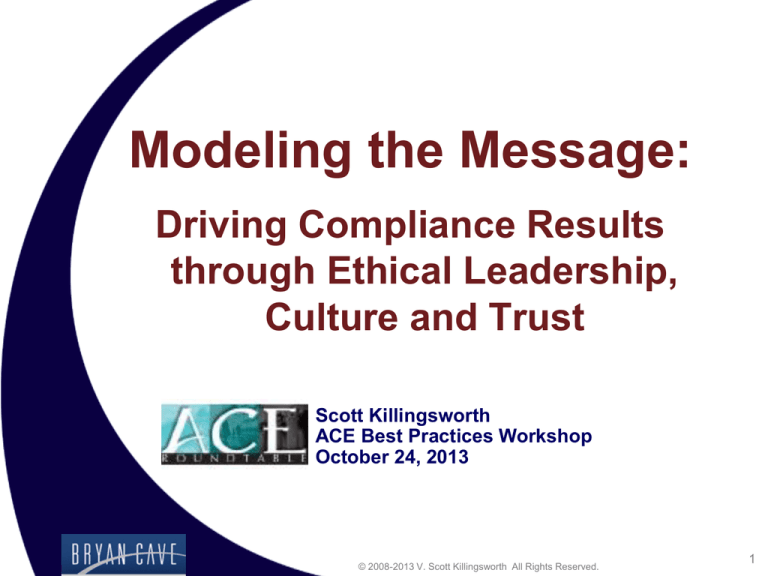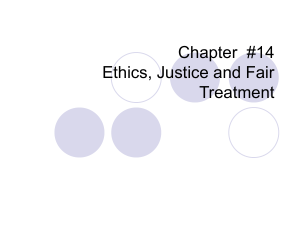
Modeling the Message:
Driving Compliance Results
through Ethical Leadership,
Culture and Trust
Scott Killingsworth
ACE Best Practices Workshop
October 24, 2013
© 2008-2013 V. Scott Killingsworth All Rights Reserved.
1
If people are good only because they fear
punishment, and hope for reward, then we are a
sorry lot indeed.
— Albert Einstein
Culture, more than rule books, determines how
an organization behaves.
— Warren Buffett
© 2008-2013 V. Scott Killingsworth All Rights Reserved.
2
Agenda
› Command and Control Compliance Model
› …and its limitations
› Values-Based Model
› Pioneering Studies on Comparative Effectiveness
› Legitimacy: What Gives Your Rules Moral Authority?
› Group Dynamics, Commitment and Framing
› How Culture Operates, and What it Can Do
› Leadership’s Roles in a Healthy Culture
› Compliance and Ethics Program Opportunities
© 2008-2013 V. Scott Killingsworth All Rights Reserved.
3
Command and Control
Compliance Model
› Aims to control or influence employee behavior
mainly through negative and positive incentives
› Based on the “rational choice theory” of classical
economics:
› We compare Reward for Misconduct to Risk
Severity of Punishment
Probability of Detection
= Estimated Risk
› Highest number wins – Risk or Reward
› Heavy reliance on specific rules, plus monitoring,
detection, punishment and deterrence to increase
perception of risk
© 2008-2013 V. Scott Killingsworth All Rights Reserved.
4
Command and Control
Limitations
Even if we accept the rational-choice assumption,
Command and Control has built-in limits:
›Only two levers for improving results:
› Very costly to increase perceived risk via better
detection (“Cop on every corner” method)
› If punishment is too harsh, reporting of violations
declines and enforcement gets spotty
›Self-interested rational choices for individuals
aren’t always good for the organization
› A person’s situation can skew the equation
› Risk/Reward framing puts everything up for
grabs – what’s your price? – but right and wrong
should be non-negotiable
© 2008-2013 V. Scott Killingsworth All Rights Reserved.
5
Command and Control
Limitations
› Rationality is Overrated: In actual human
beings, well-known cognitive biases distort
risk/reward decision-making processes
(See, e.g. Predictably Irrational, Nudge,
Thinking Fast and Slow, The (Honest) Truth
about Dishonesty, Freakonomics)
› We consistently over-value definite, near-term
events – such as the rewards of rule-breaking
› We under-value uncertain, future events,
even if catastrophic – such as the risk of
getting caught
Source: Messick and Bazerman, “Ethical Leadership and the Psychology of
Decisionmaking”
© 2008-2013 V. Scott Killingsworth All Rights Reserved.
6
Command and Control
Limitations
› More cognitive biases that distort risk/reward and
ethical judgments:
› Self-Serving Bias and Conflicts of Interest
› Overconfidence, Confirmation Bias and Motivated
Reasoning
› Authority Bias and Conformity Pressures
› Remember the Milgram and Asch experiments?
Sources: Messick and Bazerman, “Ethical Leadership and the Psychology of
Decisionmaking”;; Kim, The Banality of Fraud: Re-situating the Inside Counsel as
Gatekeeper; Milgram, Behavioral Study of Obedience; Asch, S. E. Effects of Group
Pressure upon the Modification and Distortion of Judgment
© 2008-2013 V. Scott Killingsworth All Rights Reserved.
7
Command and Control
Limitations
› Hidden costs of strong Command-and-Control Focus:
› Mistrust of employees signaled through multiple channels
› Reverse Pygmalion effect: projection of negative
expectations may be self-fulfilling
› Adversarial relationship with employees – resentment and
backlash misconduct (Reactivity effect)
› Risk/Reward framing can crowd out ethical thinking
› Deterrence message is one of pursuing self-interest
(avoiding punishment) rather than doing the right thing
› Bottom Line: Command-and-Control alone is, at best,
an inefficient (and therefore expensive) way to influence
behavior
Sources: Treviño, Weaver, et. al; Stansbury and Barry, Ethics Programs and the
Paradox of Control; Ayers and Braithwaite, Responsive Regulation: Transcending the
Deregulation Debate
© 2008-2013 V. Scott Killingsworth All Rights Reserved.
8
Values-Based Approach –
The Paradigm Shift
› Traditional Command and Control Paradigm:
› Prevent “bad” employees (5%? 20%?) from breaking rules
› Forcibly impose Company standards and values upon
recalcitrant employees
› Business and rules-based framing
› Values-based, Self-Regulatory Paradigm
› Harness the positive values of good people (80%? 95%?)
› Make sure Company is seen as measuring up to employee’s
values
› Ethical and social framing
› To win loyalty – and voluntary adherence to rules – show
that the company deserves it – Walk the talk
© 2008-2013 V. Scott Killingsworth All Rights Reserved.
9
Values-Based Approach: Motivating
Compliance via Ethical Culture
› Ethical Culture = Engaging Employee Values so that
Employees Identify Positively with the Organization
and Act Accordingly
› “Your values are what you do when no one is
looking”
› When employee aligns with Company values, motivation is
intrinsic, compliance is voluntary and doesn’t depend on
monitoring, detection and fear of punishment
› Tyler’s Studies of Workplace Compliance:
› Value-based factors (legitimacy and value congruence)
explained over 80% of variance in compliance behaviors
› Punishment and reward systems explained less than 20%
Source: Tyler, Deinhart, & Thomas, “The Ethical Commitment to Compliance:
Building Value-Based Cultures”
© 2008-2013 V. Scott Killingsworth All Rights Reserved.
10
Culture and Compliance
“What Works and What Hurts”: Very Large-Scale study of
Effect of Cultural Factors on Compliance Outcomes
1. Values-Based Compliance Programs produce better results than
those with a Command-and-Control, deterrence emphasis.
2.
Cultural Markers
Compliance Goals
› Ethical leadership (Executive
and Supervisory levels)
› Fair treatment of employees
› Rewarding ethical behavior
› Punishing misconduct
› Open discussion of ethical
issues
› Ethical issues considered in
decisionmaking
› Employee and Community
Focus
› Reducing unethical
conduct
› Reporting misconduct
› Increasing awareness of
ethical issues
› Increasing advice-seeking on
ethical issues
› Comfort delivering bad news
› Better ethical decisionmaking
› Increasing employee
commitment to employer
Source: Treviño, Weaver, Gibson and Toffler, “Managing Ethics and Legal Compliance:
What Works and What Hurts, Cal. Mgmt. Rev., Vol. 41, NO. 2, 131 (1999)
© 2008-2013 V. Scott Killingsworth All Rights Reserved.
11
Values-Based Approach -Legitimacy and Culture
› What Drives Voluntary Adherence to Rules? (Tyler)
› Company’s values and policies are perceived as
measuring up to employee’s moral values
› Company is perceived as a legitimate source of
authority: employee believes it deserves to have its
rules followed
› These factors are more influential than likelihood of
detection or fear of punishment (80/20)
› So, how can we promote these perceptions?
PSYCHOPATHS
TARGET POPULATION
SAINTS
› Measuring up on values: “When managers say ‘ethics,’
employees hear ‘fairness.’”
Sources: Tyler, Deinhart, & Thomas; Treviño,
Weaver, Gibson & Toffler
© 2008-2013 V. Scott Killingsworth All Rights Reserved.
12
Values-Based Approach –
Fairness, Legitimacy and Culture
› Fairness Perceptions and Ethics Outcomes
(Treviño and Weaver)
› Measured effects of company’s perceived fairness
to employees
› Fairness strongly correlated with less observed
unethical conduct and with more reporting of
infractions
› What Works/What Hurts: Fair treatment had the
strongest correlation with employee commitment
to the company and with comfort delivering bad
news
Source: Treviño and Weaver, “Employees’ Fairness Perceptions and
Ethics-Related Outcomes in Organizations,” chapter in Managing
Ethics in Business Organizations (2003)
© 2008-2013 V. Scott Killingsworth All Rights Reserved.
13
Values-Based Approach -Legitimacy and Culture
› Leading criteria for legitimacy of authority
› Procedural fairness in decision-making
› Quality of interpersonal treatment of employee
› These factors are more influential than:
› Fairness of actual decision outcomes
› Whether outcomes are favorable to employee
› Risk of punishment
› Rewards of employment: salary and incentives
Source: Tyler, Deinhart, &
Thomas
© 2008-2013 V. Scott Killingsworth All Rights Reserved.
14
Values-Based Approach-Legitimacy and Culture
› What is Procedural Fairness?
›
›
›
›
›
Opportunity for input from affected persons
Understandable, articulated rules and processes
Consistency over time and across similar cases
Objectivity: Same rules for everybody
Communicate reasons for decisions
› What Is Quality Interpersonal Treatment?
› Respect employees’ rights: necessary but not sufficient
› Courtesy and dignity – respect the person
› Listen
› Communicate reasons for decisions
› Employee feels trusted
© 2008-2013 V. Scott Killingsworth
Source: Tyler,
Deinhart, & Thomas 15
All Rights Reserved.
Values-Based Approach –
Trust is the Glue
› Managers at all levels must earn trust
› Values → consistent, coherent, predictable behavior → trust
› Actions speak louder than words (or Codes of Conduct)
› “Mood in the Middle” as well as Tone at the Top
› Treatment of employees is paramount
› Interactions with third parties matter too
› Social Media: untrustworthy to one → known by all
› Four leadership drivers of ethical culture (CEB):
› Honesty – truthfulness, promise-keeping
› Respecting and trusting employees
› Listening carefully to the opinions of others
› Taking action on verified misconduct
› All 4 relate to employee trust in management
Source:
Tyler, Deinhart,
& Thomas
© 2008-2013 V. Scott Killingsworth All Rights Reserved.
16
Consistency is Crucial
“It takes many good deeds to build a good
reputation, and only one bad one to lose it”
-Benjamin Franklin
“Quotations found on the Internet are
not always accurate.”
-Abraham Lincoln
“Bad is Stronger than Good”
-Review of General Psychology, Vol 5 No. 4
(December 2001) by Baumeister, Bratslavsky,
Finkenauer and Vohs.
© 2008-2013 V. Scott Killingsworth All Rights Reserved.
17
Culture and Misconduct – The
Role of Trust
100%
90%
80%
70%
60%
50%
40%
30%
20%
10%
0%
% of Workers
Witnessing
Misconduct per
Year
0
1
2
3
4
5
Number of Negative Workplace
Factors Present
›
Ethics Resource Center identified
5 “Negative Work Environment”
factors:
› Success is rewarded
regardless whether achieved
through questionable means
› Mistrust of top management’s
promises and commitments
› Mistrust of supervisors’
promises and commitments
› Dissatisfaction with
information from top
management
› Dissatisfaction with
information from supervisors
Strong correlation between these
negative factors and workplace
misconduct
Source: Ethics Research Center, 2007 Business Ethics Survey
© 2008-2013 V. Scott Killingsworth All Rights Reserved.
18
Group Dynamics, Commitment
and Framing
› People use groups to support and nourish our
identities and our positive self-concepts
› Identification with the group promotes
commitment, engagement and cooperation
› Fair and respectful treatment
› Tells employees that they are important and
valued
› Promotes trust
› Encourages identification, commitment, and
cooperation with the group
› Pride in the group also encourages
identification
Sources: Tyler and Blader, “The Group Engagement Model: Procedural Justice, Social Identity
and Cooperative Behavior, Personality and Social Psychology Review, 7: 349 (2003);
Ariely, “The Cost of Social Norms,” chapter in Predictably Irrational (2008).
19
© 2008-2013 V. Scott Killingsworth All Rights Reserved.
Group Dynamics, Commitment
and Framing
› Social/Group norms can govern behavior more
effectively than market norms
› Social norms = Culture
› Market norms = Reward and Punishment
› Social vs. market framing: People will do
things for free, for social reasons, that they
won’t do for money; and social penalties can
trump economic ones
› The power of social PLUS ethical framing:
“Around here, we do what’s right.”
Sources: Tyler and Blader, “The Group Engagement Model: Procedural Justice, Social Identity
and Cooperative Behavior, Personality and Social Psychology Review, 7: 349 (2003);
Ariely, “The Cost of Social Norms,” chapter in Predictably Irrational (2008).
20
© 2008-2013 V. Scott Killingsworth All Rights Reserved.
Promoting Employee
Commitment
› Employee commitment (engagement)
strongly linked to:
› Management’s actions show character and
integrity
› Management welcomes those seeking
advice about reporting policy violations
› Clear guidelines for acceptable behavior
› All 9 Ethical Culture measures in the What
Works/What Hurts study
Sources: McDowell, “The Hidden Bonus in ‘Doing the Right Thing; Treviño, Weaver, Gibson
and Toffler
© 2008-2013 V. Scott Killingsworth All Rights Reserved.
Committed Employees Boost
Compliance and Peformance
› Benefits of Committed Workforce
› Voluntary rule adherence
› Less need for surveillance/monitoring
› More likely to report misconduct, which means:
› Less accommodating environment for rule-breakers – more
“eyes on the street”
› Significant increase in voluntary actions to benefit the
organization
› Oh, by the way, also:
› Higher sales, profits, customer satisfaction and
loyalty
› Lower turnover
Sources: Tyler, Dienhart, and Thomas; Ethics Resource Center, 2009 NBES,
Supplemental Research Brief on Ethics and Employee Engagement; Harter et al,
Well-Being in the Workplace and its Relationship to Business Outcomes
© 2008-2013 V. Scott Killingsworth All Rights Reserved.
22
Do We Notice a Pattern?
DIMENSION
Leadership and
Modeling
Interpersonal
Treatment
Justice,
Accountability,
Follow-Up on
Misconduct
Communication
Trevino and
Weaver
Cultural
Factors that
Drive
Compliance
Tyler
Legitimacy and
Voluntary
Compliance
Ethics Resource
Center
Favorable
Perception of
Management
Ethical
leadership
Employee trust
of supervisor
and
management
Modeling good
behavior;
keeping
commitments
Fair treatment
of employees
– courtesy,
respect,
dignity
Quality of
interpersonal
treatment –
courtesy,
respect, trust
towards
employee
Follow-up on
reports of
misconduct;
rewarding
ethical
behavior;
consistent
treatment
Procedural
fairness;
same rules for
everybody;
consistency
Open
discussion of
ethical issues
Listen;
opportunity for
input from
affected
persons;
communicate
reasons for
decisions
Corporate
Executive
Board – CELC
Leadership
Attributes that
Drive Integrity
Corporate
Executive
Board – CELC
Leading
indicators of
Misconduct
Honesty
Co-workers
compromise
values for power
and control
Respect and
trust employees
Lack of trust and
respect from
direct manager
Maintaining
accountability
among all
employees across
the business
Taking action on
verified unethical
conduct
Fear of
retaliation;
discomfort
speaking up
Good
communications,
including
communications
on ethics
Listening
carefully to the
opinions of
others
Discomfort
speaking up
23
© 2008-2013 V. Scott Killingsworth All Rights Reserved.
Building Culture
RESULTS
Co-Workers’
Actions
ACTIONS AND
BEHAVIORS
BELIEFS AND
ATTITUDES
MANAGEMENT’S
WORDS (Code,
policies,
procedures,
training…)
EXPERIENCES
Management’s
Actions
LIFE
© 2008-2013 V. Scott Killingsworth All Rights Reserved.
24
Effect of Ethical Culture
Culture Strength and Observed Misconduct
100%
90%
80%
70%
Percentage of
employees
observing
misconduct
60%
50%
40%
30%
20%
10%
0%
Weak
Weak-Leaning Strong-Leaning
Strong
Observed Misconduct
Source: Ethics Resource Center, 2011 National Business
Ethics Survey
© 2008-2013 V. Scott Killingsworth All Rights Reserved.
25
Effects of Ethical Culture
16.2
percentage
point swing
Source: Corporate Executive Board, “Ethical Leadership” 2010
© 2008-2013 V. Scott Killingsworth All Rights Reserved.
26
Leadership’s Role
› Leaders at all levels must take ownership of
organizational culture
› Model the message through the broader company
culture:
› Treat employees with respect and conspicuous fairness
› Keep your door and your mind open to employees
› Engage and communicate – consistently and in both
directions (listen!)
› Transparency
› About responses to misconduct
› About reasons for decisions
› Be the change you want to see; live up to employee
values and they’ll internalize yours
› Create a place where people are proud to work
© 2008-2013 V. Scott Killingsworth All Rights Reserved.
27
Program Opportunities
› Senior Executive/Board Education on Compliance
and Productivity Impact of Ethical Leadership,
Values-Based Culture and Organizational Justice
› Coordination with HR/Engagement initiatives
› Cultural Assessment and targeted responses to
areas of weakness
› Company-wide weaknesses
› “Pockets of Resistance” -- microcultures
› Integration of values and compliance
measurements into employment functions:
› Hiring and onboarding
› Evaluation, compensation, recognition, promotion
› Managers especially
› Separation (bad apple disposal and exit interviews)
© 2008-2013 V. Scott Killingsworth All Rights Reserved.
28
Program Opportunities
› Senior Executive/Board “Tone at the Top” training
› Evaluate employment decisionmaking processes
(procedural fairness, consistency, transparency, etc.)
› Ethical Decisionmaking Training
› “Speaking up” Training
› Management soft-skills training
› Values communications through multiple channels
› Storytelling (See, e.g. KathleenEdmond.com)
› Real-life examples of good and bad decisions and their
consequences
© 2008-2013 V. Scott Killingsworth All Rights Reserved.
29
Leverage Other Voices to
Get the Message Across
© 2008-2013 V. Scott Killingsworth All Rights Reserved.
30
Questions
and
Discussion
Scott Killingsworth
scott.killingsworth@bryancave.com
404.572.6702
Bryan Cave LLP
One Atlantic Center
Fourteenth Floor
1201 West Peachtree Street, NW
Atlanta, GA 30309
Tel. 404.572.6600
Fax. 404.572.6999
www.bryancave.com
© 2008-2013 V. Scott Killingsworth All Rights Reserved.
31










